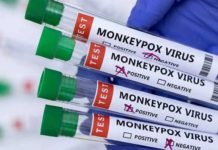A human cell is divided into various compartments, including the nucleus and the cytoplasm. The nucleus contains a cell’s genetic material, or DNA, and is the compartment where gene expression and consequently cellular function is regulated. The cytoplasm is the compartment around the nucleus where translation of gene transcripts, or mRNA, to proteins, assembly of proteins into cellular structural elements, and cellular metabolism of fats, carbohydrates, and proteins, occur. One of the ways in which the cell regulates the function of a particular protein is by controlling the protein’s location within the cell, as a specific function may only occur within a particular location. Certain proteins, including tumor suppressor proteins and other growth regulatory proteins, need to be transported from the cytoplasm, where they are made, into the nucleus where they need to be located for their primary functions to occur.
The nuclear pore is a complex gate between the nucleus and cytoplasm, closely regulating the import and export of most large molecules, called macromolecules, including many proteins, into and out of the nucleus. In healthy cells, nuclear transport processes of macromolecules in either direction through the nuclear pore are tightly regulated and require specific carrier proteins, including nuclear export proteins, to occur. There are seven known nuclear export proteins. The most well-characterized was discovered in 1999 and is called Exportin 1, or XPO1 (also called CRM1). XPO1 mediates the export of over 220 different cargo proteins, including some growth regulatory proteins and the vast majority of tumor suppressor proteins. Moreover, XPO1 appears to be the only nuclear exporter for key tumor suppressor proteins, including those generally referred to as p53, p73, FOXO, pRB, BRCA1 and PP2A.
Cancer is a disease characterized by unregulated cell growth. Cancer typically develops when DNA in normal cells begins to fail and genes that regulate cell growth become disrupted. Tumor suppressor proteins are an integral part of the body’s natural defense mechanism in identifying and preventing cancer. They exert their effects on cancer cells once DNA damage is detected by promoting apoptosis. Tumor suppressor proteins can also have an anti-cancer effect by dampening unregulated cell growth and division. In addition to tumor suppressor proteins, cells contain growth regulatory proteins that, when located in the nucleus, are involved in ensuring that cells undergo cell division, or cell growth, only under appropriate circumstances, such as repairing wounds, increasing cell numbers to deal with damage to an organ, or replacing cells that have died through normal circumstances. Growth regulatory proteins are also exported from the nucleus by XPO1 in all cells. Examples of well-characterized growth regulatory proteins are p21, p27 and E2F4.
XPO1 is also the only exporter of the anti-inflammatory protein IκB, the inhibitor of NF-κB. NF-κB is known to play a role in cancer metastasis and resistance to chemotherapy as well as in many inflammatory and autoimmune diseases. Its inhibition may be beneficial in overcoming chemotherapy resistance and in treating inflammatory and autoimmune diseases.
Because tumor suppressor proteins need to be located in the nucleus in order to carry out their anti-cancer activities, their nuclear export, or exit from the nucleus, leads to their being unavailable in the nucleus to identify cancer cells and initiate their death. As XPO1 levels have been shown to be elevated by two- to four-fold in nearly all cancer cells compared to their normal cell counterparts, it appears that cancer cells have co-opted XPO1 to move tumor suppressor proteins out of the nucleus, thereby adversely affecting their ability to identify and initiate the death of cancer cells. Increased levels of XPO1 in cancer cells also lead to excessive nuclear export of growth regulatory proteins and allow cancer cells to divide continuously and inappropriately. Higher levels of XPO1 expression are also generally correlated with poor prognosis and/or resistance to chemotherapies. The figure below depicts the process by which XPO1 mediates the nuclear transport process.
OUR APPROACH: Targeting Nuclear Export with Selective Inhibitor of Nuclear Export, or SINE™ Compounds
Since the discovery of XPO1, a growing body of research has documented that the high levels of XPO1 found in cancer cells are associated with the transport of tumor suppressor proteins and growth regulatory proteins from their site of action in the nucleus into the cytoplasm, where their anti-cancer activity is minimal and they are ultimately degraded. The inhibition of XPO1 cargo binding has been studied for over ten years. XPO1 inhibitors block the nuclear export of tumor suppressor proteins and growth regulatory proteins, leading to accumulation of these proteins in the nucleus and enhancing their anti-cancer activity in the cell. The forced nuclear retention of these proteins can counteract a multitude of the oncogenic pathways that allow cancer cells with severe DNA damage to continue to grow and divide in an unrestrained fashion.
One naturally occurring XPO1 inhibitor called leptomycin B has been shown to have potent anti-cancer activity in vitro, but has been toxic to normal cells. These toxicities to normal cells have been observed in both animals and humans, which we believe are most likely caused by the irreversible nature of leptomycin B binding to XPO1. Because of its observed toxicities in animals and humans, to our knowledge, leptomycin B is no longer being developed.
Our lead drug candidates are first-in-class, oral Selective Inhibitor of Nuclear Export, or SINE™ compounds. SINE™ compounds inhibit XPO1-mediated nuclear-cytoplasmic transport by transiently binding to the XPO1 cargo binding site, meaning that they block XPO1 cargo binding over an extended period of time, but do not permanently do so. Transient XPO1 inhibition, or inhibition of approximately 12 to 24 hours, which corresponds to the inhibition period that we have observed to date with SINE™ compounds, appears to be sufficient for nuclear retention and the increase of tumor suppressor proteins in the nucleus. During this period, the inhibition of XPO1 cargo binding enables tumor suppressor proteins to accumulate in the nucleus of cancer cells and perform their normal role of detecting DNA damage, thereby inhibiting a cancer cell’s ability to divide and promoting apoptosis. Healthy cells also build up tumor suppressor proteins in the presence of a SINE™ compound, but are able to resume normal activity after transient XPO1 inhibition because they have an intact genome with minimal or no DNA damage. The figure below depicts the process by which SINE™ compounds inhibit the XPO1 nuclear export of tumor suppressor proteins.
Transient XPO1 Inhibition by SINE™ Compounds
XPO1-inhibiting SINE™ compounds, including selinexor, have the potential to provide a novel therapy that enable tumor suppressor proteins to remain in the nucleus and promote apoptosis of cancer cells. Moreover, our SINE™ compounds spare normal cells, which, unlike cancer cells, do not have significant damage to their genetic material, and we believe this selectivity for cancer cells minimizes side effects. We believe that the oral administration of selinexor and the lack of cumulative or major organ toxicities observed to date in patients treated with selinexor in our Phase 1 clinical trials create the potential for its broad use across many cancer types, including both hematological and solid tumor malignancies. We believe that no currently approved or current clinical-stage cancer drug candidates are selectively targeting the restoration and increase in the levels of multiple tumor suppressor proteins in the nucleus. In addition to cancer, we believe that SINE™ compounds have the potential to provide therapeutic benefit in a number of additional indications, including autoimmune and inflammatory diseases, wound healing, HIV and influenza. We are developing a pipeline of SINE™ compounds that have shown evidence of activity in preclinical models of inflammation, wound healing and viral infection. Specifically, SINE™ compounds have shown potent preliminary evidence of anti-inflammatory activity in several animal models of inflammation, including systemic lupus erythematosus, multiple sclerosis and rheumatoid arthritis. SINE™ compounds have also shown preliminary evidence of activity as topical formulations in wound healing by accelerating wound closure and improving wound appearance in both mouse and pig models of surgical and/or knife wounds. In addition, SINE™ compounds have shown preliminary evidence in preclinical studies of activity against specific viruses which require XPO1 for their replication, including HIV and influenza.

























